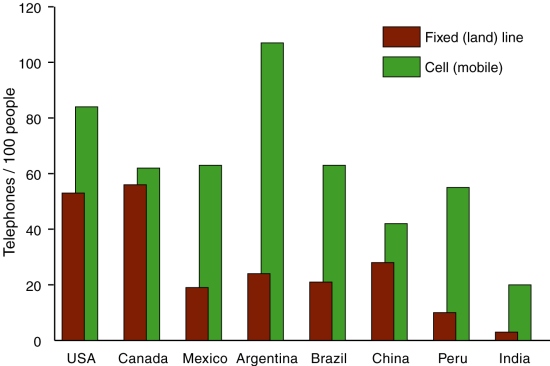Mexico’s first telephone line was erected in Puebla in the early 1880s. Before long, the Mexican Telephone Company, a subsidiary of Bell, was operating in Mexico City. The first telephone lines did not work very well and were limited to downtown areas. Only public officials, police stations, a few select businesses and the wealthy used the telephone service.
The growth of telephony was slow because it lacked strong government support, was expensive and had a very limited range. By 1893 telephone services had spread to 13 more cities even though intercity lines would not become available until much later. In about 1950 all Mexico’s telephone companies were purchased by a single group of investors to form Teléfonos de México (Telmex) which established a monopoly. Even after the government nationalized the company in 1972, few incentives were offered for expansion and it was still almost impossible to obtain a new telephone line.
In 1990 Telmex was re-privatized in one of Mexico’s largest, most complicated and most controversial privatizations. The government sold majority voting rights and a 20% stake in Telmex to a consortium of investors for $1.8 billion and it sold $3.7 billion in shares to the public. The newly privatized Telmex invested significantly in the mid 1990s, enabling millions to get new lines but raising rates dramatically. Competitors were allowed to enter the telephone market but Telmex has remained the dominant player, especially for residential services. It remains fashionable for its customers to complain about its poor service and very high long distance rates.
Mexico and the USA are closely linked by telephone. Over 90% of the international calls from Mexico go to the USA whereas roughly 13% of all US international calls go to Mexico.
For a country of Mexico’s wealth and sophistication, it lags behind most of the world in telephony (see graph). In 2007, Mexico had 19 fixed telephone lines per 100 population compared to 53 in the USA and 56 in Canada. The Federal District had the best service with about 50 fixed telephone lines per 100 people, followed by Nuevo León with 33 and Baja California with 27. Chiapas had the fewest with only 5 per 100, not far behind Oaxaca with 6 and Tabasco with 7. Telephone communications are difficult or inconvenient in these southern states; this limits their residents’ quality of life and economic competitiveness. Other states with poor telephone service (less than 12 lines per 100 people) are Hidalgo, Zacatecas, Campeche, Tlaxcala, Guerrero, Veracruz and San Luis Potosí.
Mexicans have better access to cell phones than fixed lines with 63% of the population owning one in 2007, compared to 84% in the USA, 62% in Canada and a staggering 107% (more than one cell phone per person) in Argentina. While lagging slightly behind Guatemala where 76% of the population has a cell phone, a higher percentage of people in Mexico use cell phones than in China or India.
Cell phone use in Mexico has grown rapidly in the capital and other big cities but has also grown spectacularly in southern and rural areas where there are few wired telephones. Many rural villages with only a few fixed line phones now have dozens of cell phones, mostly used by those under age thirty. When asked why they don’t use cell phones more, some older rural adults say they find cell phones too complicated because of their many small buttons.
Many rural residents get cell phones from relatives who have migrated to the USA. They avoid monthly fees by buying pre-paid cell phone cards when they have the money. When the card runs out, they make no calls until they can afford to buy another one. Some enterprising rural residents use their cell phone as a pay phone. In short, cell phone technology has greatly improved communications in many Mexican rural areas.
Related posts:

Sorry, the comment form is closed at this time.